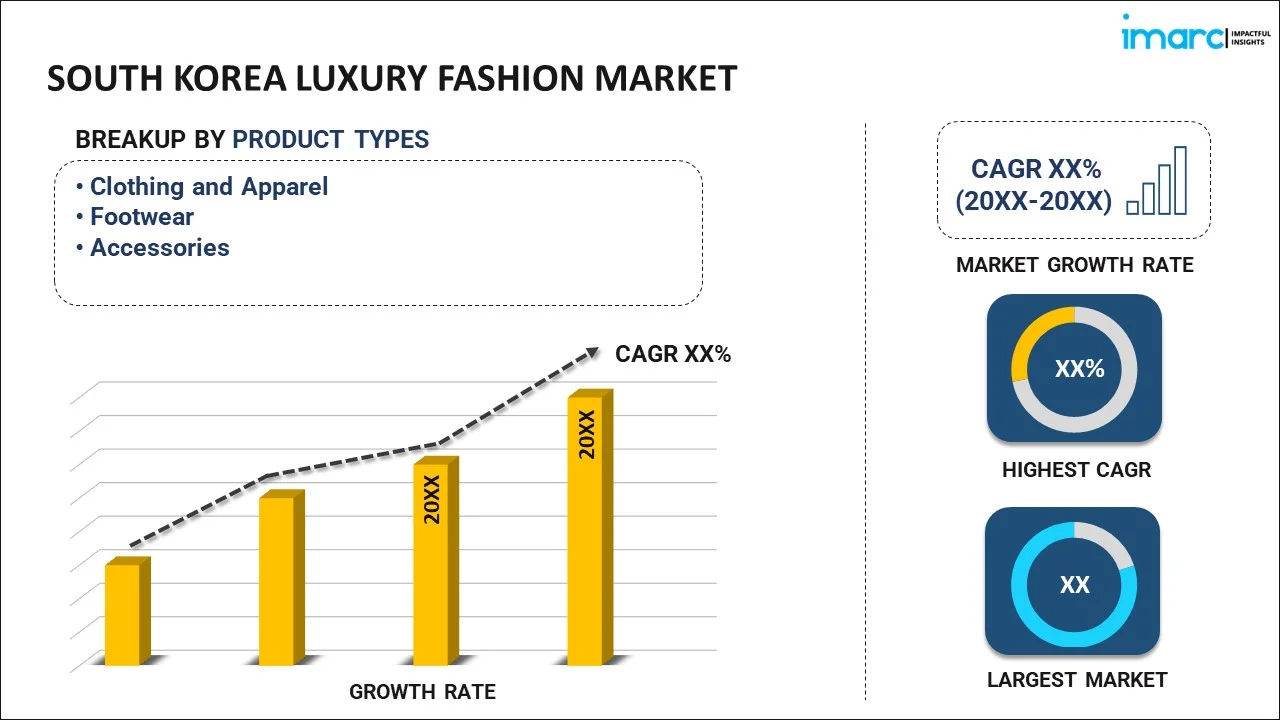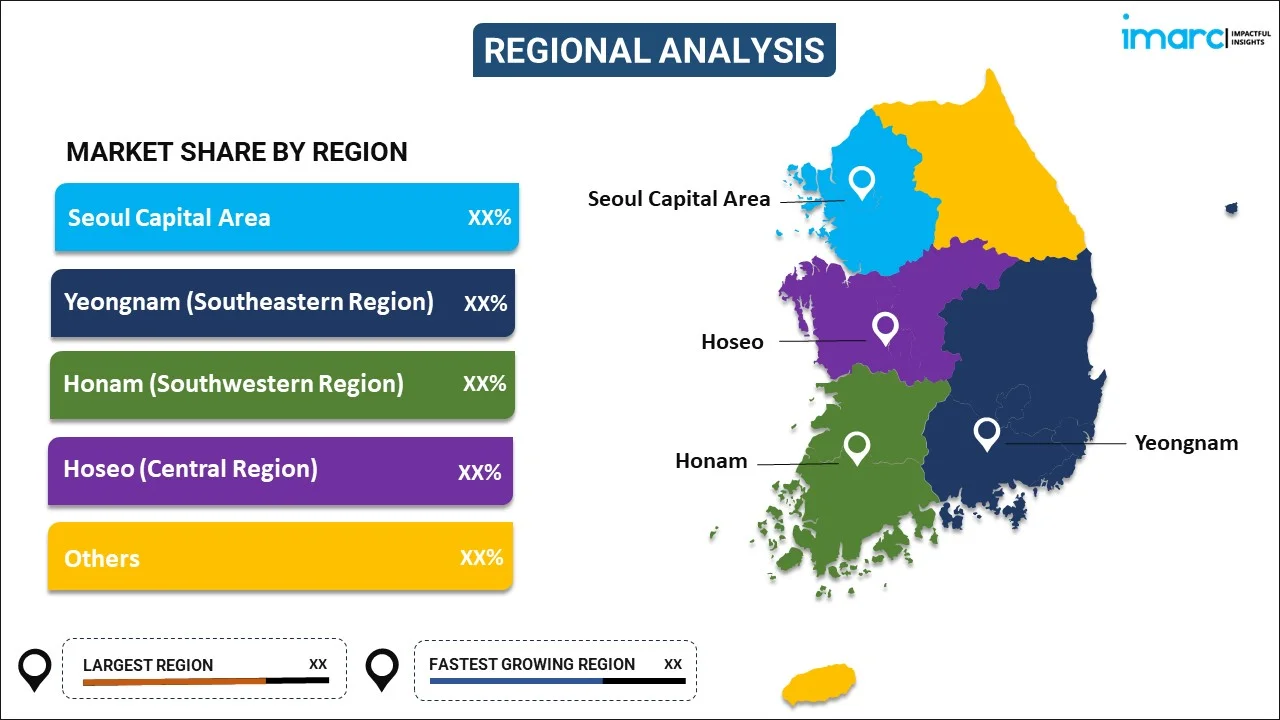
South Korea Luxury Fashion Market Report by Product Type (Clothing and Apparel, Footwear, Accessories), Distribution Channel (Store-Based, Non-Store Based), End User (Men, Women, Unisex), and Region 2024-2032
Market Overview:
South Korea luxury fashion market size is projected to exhibit a growth rate (CAGR) of 5.05% during 2024-2032. The expanding e-commerce industry, rising preferences of individuals to stay updated with the latest trends, and increasing collaborations of luxury brands with celebrities, designers, and artists to create limited-edition collections represent some of the key factors driving the market.
|
Report Attribute
|
Key Statistics
|
|---|---|
|
Base Year
|
2023 |
|
Forecast Years
|
2024-2032
|
|
Historical Years
|
2018-2023
|
| Market Growth Rate (2024-2032) | 5.05% |
Luxury fashion consists of high-end clothing, accessories, and footwear that are typically characterized by exceptional quality, craftsmanship, and exclusivity. It is characterized by its innovative and artistic designs. It is crafted with precision and the use of the finest materials, ensuring longevity and durability. It often comprises limited edition collections, which are produced in very small quantities. It allows individuals to express their individuality and personal style through unique, often one-of-a-kind, pieces. In addition, as it supports the work of talented designers and artisans who create these exquisite pieces, the demand for luxury fashion items is increasing across South Korea.
South Korea Luxury Fashion Market Trends:
The high-income levels of individuals in South Korea are allowing them to invest in luxury fashion products. This, coupled with the rising fashion consciousness among the masses and their rising preferences to stay up to date with the latest trends, represents one of the key factors driving the demand for luxury brands that offer cutting-edge designs and exclusivity. Furthermore, the increasing consciousness among the people about sustainability and ethical production processes is offering a favorable market outlook. Apart from this, the rising popularity of cultural exports is strengthening the growth of the market. Furthermore, the widespread adoption of smartphones and the rising reliance on e-commerce platforms are offering a favorable market outlook in the country. Online shopping allows people to access a wide range of products and brands, thereby increasing convenience and bolstering the market growth. Moreover, a continuous rise of the travel and tourism industry in South Korea and the increasing number of visitors from around the world are influencing the market positively. Tourists often prefer buying luxury fashion products as souvenirs to take advantage of tax-free shopping. In line with this, many luxury brands are expanding their presence in South Korea by opening flagship stores and boutiques in prime locations, thereby enhancing brand visibility and accessibility to individuals. In addition, several luxury brands are collaborating with South Korean celebrities, designers, and artists to create limited-edition collections. These collaborations generate excitement and drive consumer engagement. Leading market players are also offering personalized shopping experiences and made-to-order services in South Korea. As a result, people can customize their luxury fashion items, adding a sense of exclusivity and individuality to their purchases. Moreover, the rising preferences of individuals in South Korea to purchase pre-owned luxury products at affordable prices are facilitating the overall growth of the market in the country.
South Korea Luxury Fashion Market Segmentation:
IMARC Group provides an analysis of the key trends in each segment of the market, along with forecasts at the country level for 2024-2032. Our report has categorized the market based on product type, distribution channel, and end user.
Product Type Insights:

- Clothing and Apparel
- Jackets and Coats
- Skirts
- Shirts and T-Shirts
- Dresses
- Trousers and Shorts
- Denim
- Underwear and Lingerie
- Others
- Footwear
- Accessories
- Gems and Jewellery
- Belts
- Bags
- Watches
The report has provided a detailed breakup and analysis of the market based on the product type. This includes clothing and apparel (jackets and coats, skirts, shirts and t-shirts, dresses, trousers and shorts, denim, underwear and lingerie, and others), footwear, and accessories (gems and jewellery, belts, bags, and watches).
Distribution Channel Insights:
- Store-Based
- Non-Store Based
A detailed breakup and analysis of the market based on the distribution channel have also been provided in the report. This includes store-based and non-store based.
End User Insights:
- Men
- Women
- Unisex
The report has provided a detailed breakup and analysis of the market based on the end user. This includes men, women, and unisex.
Regional Insights:

- Seoul Capital Area
- Yeongam (Southeastern Region)
- Honam (Southwestern Region)
- Hoseo (Central Region)
- Others
The report has also provided a comprehensive analysis of all the major regional markets, which include Seoul Capital Area, Yeongam (Southeastern Region), Honam (Southwestern Region), Hoseo (Central Region), and Others.
Competitive Landscape:
The market research report has also provided a comprehensive analysis of the competitive landscape in the market. Competitive analysis such as market structure, key player positioning, top winning strategies, competitive dashboard, and company evaluation quadrant has been covered in the report. Also, detailed profiles of all major companies have been provided.
South Korea Luxury Fashion Market Report Coverage:
| Report Features | Details |
|---|---|
| Base Year of the Analysis | 2023 |
| Historical Period | 2018-2023 |
| Forecast Period | 2024-2032 |
| Units | US$ Million |
| Scope of the Report | Exploration of Historical and Forecast Trends, Industry Catalysts and Challenges, Segment-Wise Historical and Predictive Market Assessment:
|
| Product Types Covered |
|
| Distribution Channels Covered | Store-Based, Non-Store Based |
| End Users Covered | Men, Women, Unisex |
| Regions Covered | Seoul Capital Area, Yeongnam (Southeastern Region), Honam (Southwestern Region), Hoseo (Central Region), Others |
| Customization Scope | 10% Free Customization |
| Report Price and Purchase Option | Single User License: US$ 3699 Five User License: US$ 4699 Corporate License: US$ 5699 |
| Post-Sale Analyst Support | 10-12 Weeks |
| Delivery Format | PDF and Excel through Email (We can also provide the editable version of the report in PPT/Word format on special request) |
Key Questions Answered in This Report:
- How has the South Korea luxury fashion market performed so far and how will it perform in the coming years?
- What has been the impact of COVID-19 on the South Korea luxury fashion market?
- What is the breakup of the South Korea luxury fashion market on the basis of product type?
- What is the breakup of the South Korea luxury fashion market on the basis of distribution channel?
- What is the breakup of the South Korea luxury fashion market on the basis of end user?
- What are the various stages in the value chain of the South Korea luxury fashion market?
- What are the key driving factors and challenges in the South Korea luxury fashion?
- What is the structure of the South Korea luxury fashion market and who are the key players?
- What is the degree of competition in the South Korea luxury fashion market?
Key Benefits for Stakeholders:
- IMARC’s industry report offers a comprehensive quantitative analysis of various market segments, historical and current market trends, market forecasts, and dynamics of the South Korea luxury fashion market from 2018-2032.
- The research report provides the latest information on the market drivers, challenges, and opportunities in the South Korea luxury fashion market.
- Porter's five forces analysis assist stakeholders in assessing the impact of new entrants, competitive rivalry, supplier power, buyer power, and the threat of substitution. It helps stakeholders to analyze the level of competition within the South Korea luxury fashion industry and its attractiveness.
- Competitive landscape allows stakeholders to understand their competitive environment and provides an insight into the current positions of key players in the market.
Need more help?
- Speak to our experienced analysts for insights on the current market scenarios.
- Include additional segments and countries to customize the report as per your requirement.
- Gain an unparalleled competitive advantage in your domain by understanding how to utilize the report and positively impacting your operations and revenue.
- For further assistance, please connect with our analysts.
 Inquire Before Buying
Inquire Before Buying
 Speak to an Analyst
Speak to an Analyst
 Request Brochure
Request Brochure
 Request Customization
Request Customization




.webp)




.webp)












